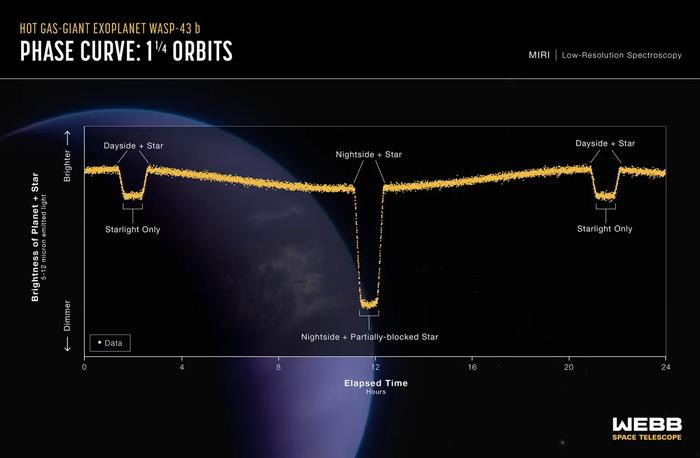NASA’s James Webb Space Telescope has successfully mapped the weather on the hot gas-giant exoplanet WASP-43 b, revealing a world of extreme temperatures, high-speed winds, and thick clouds. The investigation showcases Webb’s extraordinary ability to measure temperature variations and detect atmospheric gases on distant exoplanets, opening up new possibilities for exoplanet science.
A Tidally Locked “Hot Jupiter” with Extreme Conditions
WASP-43 b, a “hot Jupiter” exoplanet similar in size to Jupiter but much hotter, orbits its star at a distance of just 1.3 million miles. This tight orbit results in the planet being tidally locked, with one side continuously illuminated and the other in permanent darkness. Despite the nightside never receiving direct radiation from the star, strong eastward winds transport heat around the planet.
Using Webb’s MIRI (Mid-Infrared Instrument), researchers measured light from the WASP-43 system every 10 seconds for more than 24 hours. By observing over an entire orbit, they were able to calculate the temperature of different sides of the planet as it rotated into view, constructing a rough temperature map.
The measurements show that the dayside has an average temperature of nearly 2,300 degrees Fahrenheit (1,250 degrees Celsius), while the nightside is significantly cooler at 1,100 degrees Fahrenheit (600 degrees Celsius). The data also helps locate the hottest spot on the planet, which is shifted slightly eastward due to supersonic winds moving heated air.
Thick Clouds, Missing Methane, and High-Speed Winds
The broad spectrum of mid-infrared light captured by Webb also allowed researchers to measure the amount of water vapor and methane around the planet. The analysis suggests that the nightside is likely covered in a thick, high layer of clouds that prevent some of the infrared light from escaping to space, making the nightside appear dimmer and cooler than it would be without clouds.
Surprisingly, the data shows a distinct lack of methane anywhere in the atmosphere. Researchers believe that wind speeds reaching around 5,000 miles per hour move gas from the dayside to the nightside and back again so quickly that there isn’t enough time for detectable amounts of methane to form on the nightside.
The team thinks that due to this wind-driven mixing, the atmospheric chemistry is the same all the way around the planet, a finding that wasn’t apparent from past work with the Hubble and Spitzer space telescopes.
The MIRI observation of WASP-43 b was conducted as part of the Webb Early Release Science programs, which are providing researchers with a vast set of robust, open-access data for studying a wide array of cosmic phenomena. As the world’s premier space science observatory, the James Webb Space Telescope continues to solve mysteries in our solar system and beyond, probing the mysterious structures and origins of our universe.
Keyword/Phrase: Exoplanet Weather Mapping


